SKODA SUPERB 2012 2.G / (B6/3T) Service Manual
Manufacturer: SKODA, Model Year: 2012, Model line: SUPERB, Model: SKODA SUPERB 2012 2.G / (B6/3T)Pages: 235, PDF Size: 5.86 MB
Page 41 of 235

Description of the operation
First read and observe the introductory information given on page 38.When operating the lid, the system distinguishes 3 areas » Fig. 22 on page 38
where the function of the individual operating elements changes. The end posi-
tions of the lid - fully closed in the secured lock and fully opened - differ as well.
Explanation of symbols
Feasible action
Non-feasible action
Movement in the opposite direction to the previous movement Operation of the boot lid using the remote control key and the button on the
centre console
Action Closed
lid Area
Open
lid 1 2 3
Opening
Stop
Closing When the ignition is switched on, the operation of the boot lid does not function
using the remote control key.
If the vehicle was locked from the outside, the operation of the boot lid does not
function using the button on the centre console » Fig. 22 on page 38.
If a trailer is coupled to the vehicle, the operation of the boot lid does not func-
tion using the remote control key or the button on the centre console.
Operation of the boot lid using the handle A
Action
Closed
lid Area
Open
lid 1 2 3
Opening
Stop
Closing The operation of the boot lid, using the handle A
is only possible when the vehi-
cle is unlocked » Fig. 21 on page 38.
ä
Operation of the boot lid using the inner button B
Action
Closed
lid Area
Open
lid 1 2 3
Opening
Stop
Closing Operating the boot lid with the inner button B
is only possible when the boot lid
is opened » Fig. 21 on page 38. Ð Audible signals
First read and observe the introductory information given on page
38. Audible signals are active during the electrical operation of the lid. They serve as
a safety function and provide information about the success of a performed ac-
tion.
Signals Status
Interrupted tone Open (using the button on the remote control key or the button on the centre console » Fig. 22 on page 38)
1 continuous tone Force limiter
3 rising tones Confirmation of the storage of the lid position
3 identical tones fault Note
The expansion of the area 3
» Fig. 22 on page 38 changes proportionally, de-
pending on the setting of the top position of the lid »
page 40. When adjusting
the top position of the lid in the area 2
, the area 3
is not active, the expansion
of the area 2
changes proportionally to the set top position of the lid.
Ð
ä
39
Unlocking and locking
Page 42 of 235

Adjusting the top position of the lid
First read and observe the introductory information given on page 38.If the space for opening the lid is restricted (e.g. height of garage) or for more
convenient operation (e.g. according to a person's height), it is possible to adjust
the top position of the boot lid.
Adjusting
› Stop the lid in the desired position (electrically or manually).
› Press the inner button B
» Fig. 21 on page 38 and press and hold it for approx.
3 seconds. Storing the position in the memory of the control unit is confirmed
with an audible signal.
Deleting the adjusted position
› Carefully lift up the lid manually to the maximum opening position.
› Press and hold the inner button B
» Fig. 21 on page 38 for approx. 3
seconds.
An audible signal sounds and the height which was originally set is deleted from
the memory of the control unit, while the basic position of the top lid position is
again set. Note
■ The lid always opens at the height which was last stored in the memory of the
control unit. ■ The top position which is reached when the lid opens automatically, is always
lower than the maximum top position which can be reached when the lid is
opened manually. ÐOperational problems
First read and observe the introductory information given on page
38.If the battery is disconnected and reconnected while the boot lid is open, it is
necessary to activate the electric boot lid system. Activation refers to the initiali-
sation of the control unit by manually closing the lid. Thus, the end position of the
lid is stored under fully closed in secured lock.
Possible malfunctions of the electric boot lid:
ä
ä Examples of operational malfunctions
Description of the malfunc-
tion Possible solutions
The lid cannot be lifted out of
the lock. Emergency unlocking of the lid
» page 37
The lid does not react to an
opening signal Remove the possible obstacle (e.g. snow), open
the lid again » page 39
Press the handle on the lower edge of the boot
lid and pull the lid upwards
The lid remains in the top po-
sition Manually close the lid (slowly and without sud-
den movements) Ð
Electric power windows
ä
Introduction
This chapter contains information on the following subjects:
Window open/close 41
Window in the front passenger door and the rear doors open/close 42
Force limiter of the power windows 42
Window convenience operation 42
Operational faults 43
WARNING
■ If the vehicle is locked from the outside, do not leave anybody in the vehicle
as it is not possible to open the windows from the inside in the event of an
emergency.
■ The system is fitted with a force limiter » page 42. If there is an obstacle,
the closing process is stopped and the window goes down by several centi-
metres. The windows should nevertheless be closed carefully! Otherwise
these can cause severe crushing injuries!
■ It is recommended to deactivate the electrically operated power windows in
the rear doors (safety pushbutton) S
» Fig. 23
on page 41 when children
are being transported on the rear seats. £
40 Using the system
Page 43 of 235
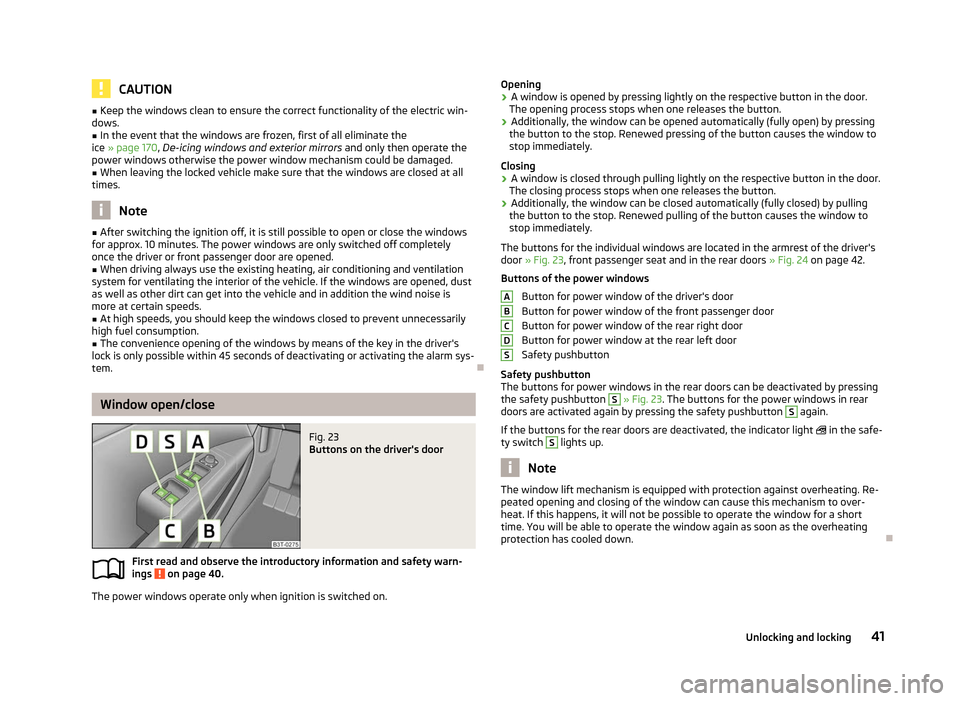
CAUTION
■ Keep the windows clean to ensure the correct functionality of the electric win-
dows. ■ In the event that the windows are frozen, first of all eliminate the
ice » page 170 , De-icing windows and exterior mirrors and only then operate the
power windows otherwise the power window mechanism could be damaged. ■ When leaving the locked vehicle make sure that the windows are closed at all
times. Note
■ After switching the ignition off, it is still possible to open or close the windows
for approx. 10
minutes. The power windows are only switched off completely
once the driver or front passenger door are opened. ■ When driving always use the existing heating, air conditioning and ventilation
system for ventilating the interior of the vehicle. If the windows are opened, dust
as well as other dirt can get into the vehicle and in addition the wind noise is
more at certain speeds.
■ At high speeds, you should keep the windows closed to prevent unnecessarily
high fuel consumption.
■ The convenience opening of the windows by means of the key in the driver's
lock is only possible within 45
seconds of deactivating or activating the alarm sys-
tem. ÐWindow open/close
Fig. 23
Buttons on the driver's door
First read and observe the introductory information and safety warn-
ings on page 40.
The power windows operate only when ignition is switched on.
ä Opening
› A window is opened by pressing lightly on the respective button in the door.
The opening process stops when one releases the button.
› Additionally, the window can be opened automatically (fully open) by pressing
the button to the stop. Renewed pressing of the button causes the window to
stop immediately.
Closing
› A window is closed through pulling lightly on the respective button in the door.
The closing process stops when one releases the button.
› Additionally, the window can be closed automatically (fully closed) by pulling
the button to the stop. Renewed pulling of the button causes the window to
stop immediately.
The buttons for the individual windows are located in the armrest of the driver's
door » Fig. 23, front passenger seat and in the rear doors »
Fig. 24 on page 42.
Buttons of the power windows Button for power window of the driver's door
Button for power window of the front passenger door
Button for power window of the rear right door
Button for power window at the rear left door
Safety pushbutton
Safety pushbutton
The buttons for power windows in the rear doors can be deactivated by pressing
the safety pushbutton S
» Fig. 23. The buttons for the power windows in rear
doors are activated again by pressing the safety pushbutton S
again.
If the buttons for the rear doors are deactivated, the indicator light in the safe-
ty switch S
lights up.
Note
The window lift mechanism is equipped with protection against overheating. Re-
peated opening and closing of the window can cause this mechanism to over-
heat. If this happens, it will not be possible to operate the window for a short
time. You will be able to operate the window again as soon as the overheating
protection has cooled down. Ð A
B
C
D
S
41
Unlocking and locking
Page 44 of 235

Window in the front passenger door and the rear doors open/
close
Fig. 24
Arrangement of the button on
the rear door
First read and observe the introductory information and safety warn-
ings on page 40.
There is a button in the front passenger door and in the rear doors for that win-
dow.
Opening
› A window is opened by pressing lightly on the respective button in the door.
The opening process stops when one releases the button.
› Additionally, the window can be opened automatically (fully open) by pressing
the button to the stop. Renewed pressing of the button causes the window to
stop immediately.
Closing
› A window is closed through pulling lightly on the respective button in the door.
The closing process stops when one releases the button.
› Additionally, the window can be closed automatically (fully closed) by pulling
the button to the stop. Renewed pulling of the button causes the window to
stop immediately. ÐForce limiter of the power windows
First read and observe the introductory information and safety warn-
ings on page 40.
The electrically operated power windows are fitted with a force limiter. It reduces
the risk of bruises or injuries when closing the windows.
ä
ä If there is an obstacle, the closing process is stopped and the window goes down
by several centimetres.
If the obstacle prevents the window from being closed during the next 10 sec-
onds, the closing process is interrupted once again and the window goes down by
several centimetres.
If you attempt to close the window again within 10
seconds of the window being
moved down for the second time, even though the obstacle was not yet been re-
moved, the closing process is only stopped. During this time it is not possible to
automatically close the window. The force limiter is still switched on.
The force limiter is only switched off if you attempt to close the window again
within the next 10 seconds - the window will now close with full force!
If you wait longer than 10 seconds, the force limiter is switched on again. Ð Window convenience operation
First read and observe the introductory information and safety warn-
ings on page 40.
The electrically powered windows can be opened and closed as follows when un-
locking and locking the vehicle.
Opening
›
Press and hold the unlock button
on the remote control key.
› Press and hold the upper part of the central locking button in the driver's door.
Closing
› Press and hold the lock button
on the remote control key.
› Press and hold the lower part of the central locking button in the driver's door.
› Hold the key in the driver's lock in the lock position.
› With the KESSY system, cover the sensor 2
» Fig. 13 on page 32
.
You can interrupt the opening or closing process for the windows immediately by
releasing the key or the lock button. Ð
ä
42 Using the system
Page 45 of 235
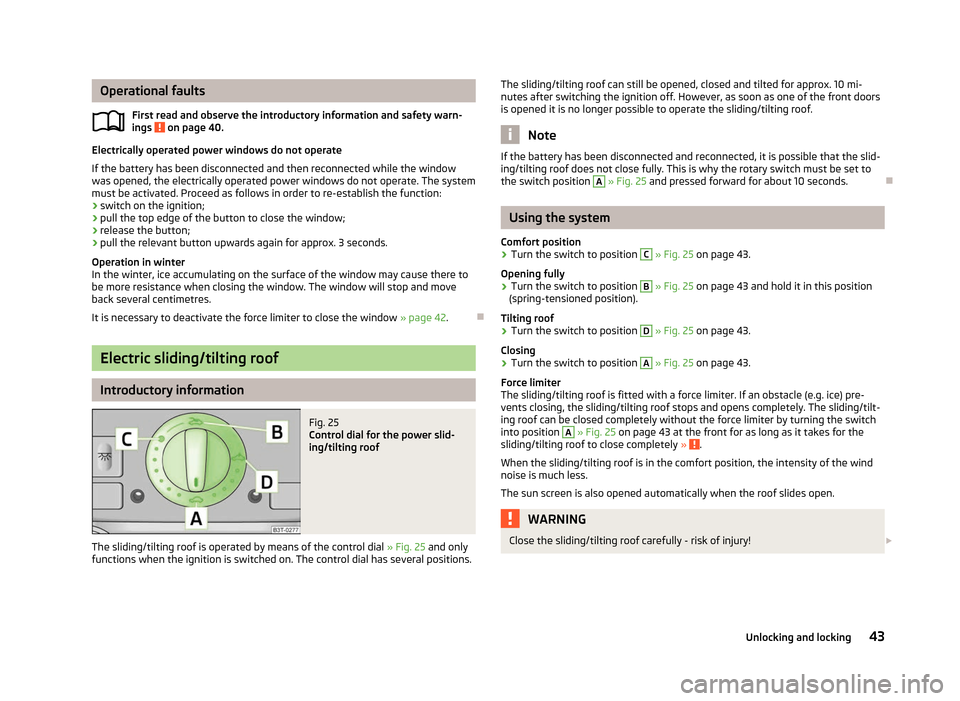
Operational faults
First read and observe the introductory information and safety warn-
ings on page 40.
Electrically operated power windows do not operate
If the battery has been disconnected and then reconnected while the window
was opened, the electrically operated power windows do not operate. The system
must be activated. Proceed as follows in order to re-establish the function:
› switch on the ignition;
› pull the top edge of the button to close the window;
› release the button;
› pull the relevant button upwards again for approx. 3
seconds.
Operation in winter
In the winter, ice accumulating on the surface of the window may cause there to
be more resistance when closing the window. The window will stop and move
back several centimetres.
It is necessary to deactivate the force limiter to close the window » page 42.ÐElectric sliding/tilting roof
Introductory information
Fig. 25
Control dial for the power slid-
ing/tilting roof
The sliding/tilting roof is operated by means of the control dial » Fig. 25 and only
functions when the ignition is switched on. The control dial has several positions.
ä
The sliding/tilting roof can still be opened, closed and tilted for approx. 10
mi-
nutes after switching the ignition off. However, as soon as one of the front doors
is opened it is no longer possible to operate the sliding/tilting roof. Note
If the battery has been disconnected and reconnected, it is possible that the slid-
ing/tilting roof does not close fully. This is why the rotary switch must be set to
the switch position A
» Fig. 25 and pressed forward for about 10
seconds.Ð Using the system
Comfort position
› Turn the switch to position C
» Fig. 25 on page 43.
Opening fully
› Turn the switch to position B
» Fig. 25 on page 43 and hold it in this position
(spring-tensioned position).
Tilting roof
› Turn the switch to position D
» Fig. 25 on page 43.
Closing
› Turn the switch to position A
» Fig. 25 on page 43.
Force limiter
The sliding/tilting roof is fitted with a force limiter. If an obstacle (e.g. ice) pre-
vents closing, the sliding/tilting roof stops and opens completely. The sliding/tilt-
ing roof can be closed completely without the force limiter by turning the switch
into position A
» Fig. 25 on page 43 at the front for as long as it takes for the
sliding/tilting roof to close completely » .
When the sliding/tilting roof is in the comfort position, the intensity of the wind
noise is much less.
The sun screen is also opened automatically when the roof slides open. WARNING
Close the sliding/tilting roof carefully - risk of injury! £
43
Unlocking and locking
Page 46 of 235
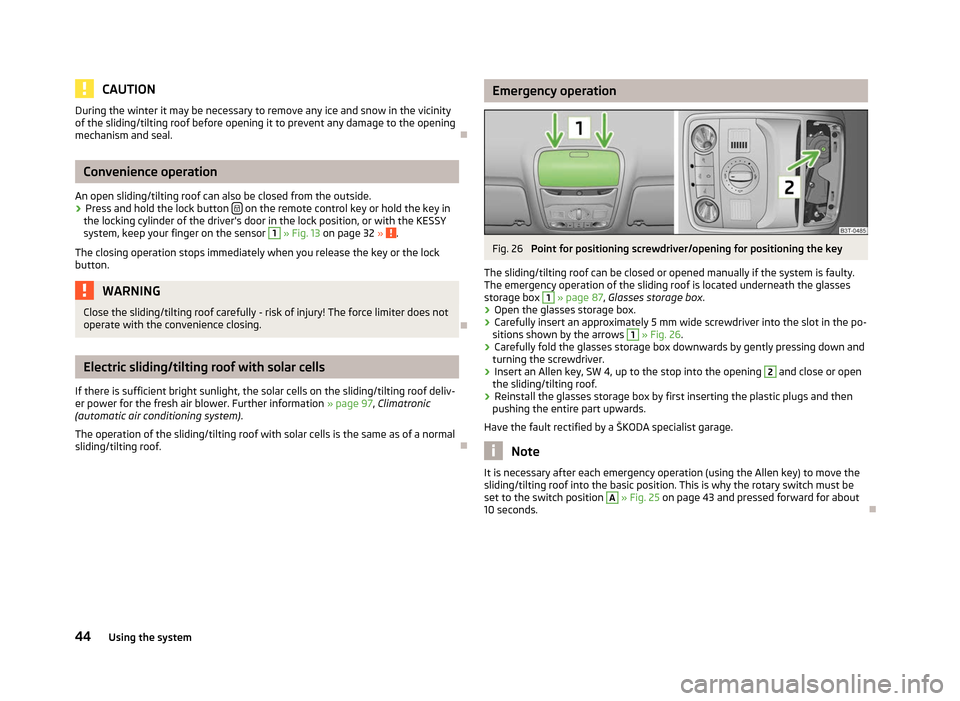
CAUTION
During the winter it may be necessary to remove any ice and snow in the vicinity
of the sliding/tilting roof before opening it to prevent any damage to the opening
mechanism and seal. ÐConvenience operation
An open sliding/tilting roof can also be closed from the outside.
› Press and hold the lock button
on the remote control key or hold the key in
the locking cylinder of the driver's door in the lock position, or with the KESSY
system, keep your finger on the sensor 1
» Fig. 13 on page 32 » .
The closing operation stops immediately when you release the key or the lock
button. WARNING
Close the sliding/tilting roof carefully - risk of injury! The force limiter does not
operate with the convenience closing. ÐElectric sliding/tilting roof with solar cells
If there is sufficient bright sunlight, the solar cells on the sliding/tilting roof deliv-
er power for the fresh air blower. Further information » page 97, Climatronic
(automatic air conditioning system) .
The operation of the sliding/tilting roof with solar cells is the same as of a normal
sliding/tilting roof. Ð Emergency operation
Fig. 26
Point for positioning screwdriver/opening for positioning the key
The sliding/tilting roof can be closed or opened manually if the system is faulty.
The emergency operation of the sliding roof is located underneath the glasses
storage box 1
» page 87,
Glasses storage box .
› Open the glasses storage box.
› Carefully insert an approximately 5 mm wide screwdriver into the slot in the po-
sitions shown by the arrows 1
» Fig. 26.
› Carefully fold the glasses storage box downwards by gently pressing down and
turning the screwdriver.
› Insert an Allen key, SW 4, up to the stop into the opening 2
and close or open
the sliding/tilting roof.
› Reinstall the glasses storage box by first inserting the plastic plugs and then
pushing the entire part upwards.
Have the fault rectified by a
ŠKODA specialist garage. Note
It is necessary after each emergency operation (using the Allen key) to move the
sliding/tilting roof into the basic position. This is why the rotary switch must be
set to the switch position A
» Fig. 25 on page 43 and pressed forward for about
10 seconds. Ð
44 Using the system
Page 47 of 235
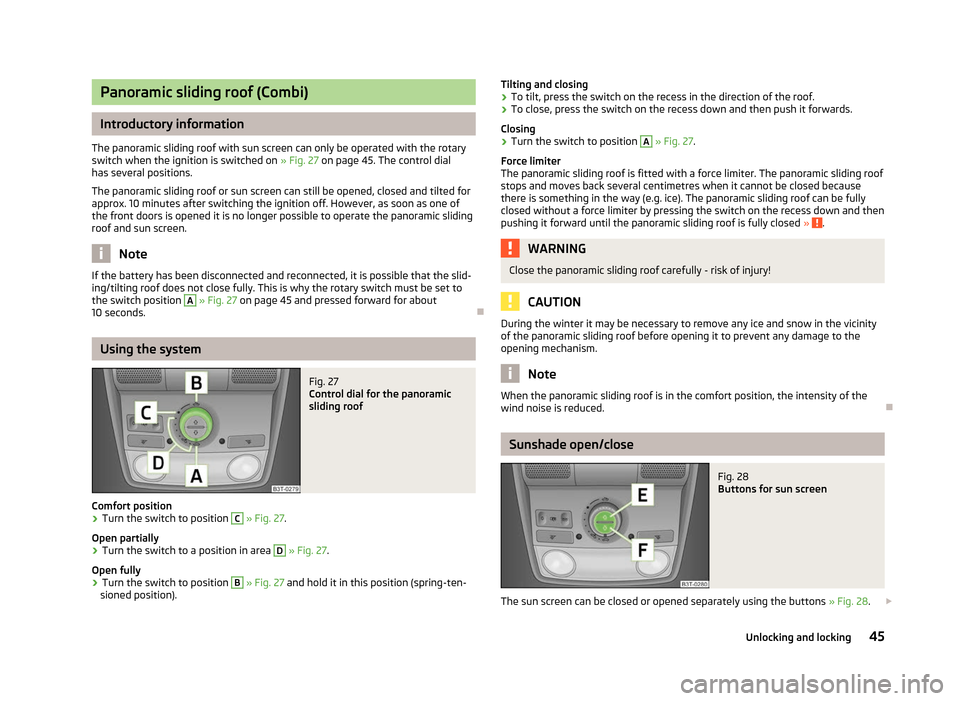
Panoramic sliding roof (Combi)
Introductory information
The panoramic sliding roof with sun screen can only be operated with the rotary
switch when the ignition is switched on » Fig. 27 on page
45. The control dial
has several positions.
The panoramic sliding roof or sun screen can still be opened, closed and tilted for
approx. 10 minutes after switching the ignition off. However, as soon as one of
the front doors is opened it is no longer possible to operate the panoramic sliding
roof and sun screen. Note
If the battery has been disconnected and reconnected, it is possible that the slid-
ing/tilting roof does not close fully. This is why the rotary switch must be set to
the switch position A
» Fig. 27
on page 45 and pressed forward for about
10 seconds. ÐUsing the system
Fig. 27
Control dial for the panoramic
sliding roof
Comfort position
› Turn the switch to position C
» Fig. 27.
Open partially
› Turn the switch to a position in area D
» Fig. 27
.
Open fully
› Turn the switch to position B
» Fig. 27 and hold it in this position (spring-ten-
sioned position). Tilting and closing
› To tilt, press the switch on the recess in the direction of the roof.
› To close, press the switch on the recess down and then push it forwards.
Closing
› Turn the switch to position A
» Fig. 27.
Force limiter
The panoramic sliding roof is fitted with a force limiter. The panoramic sliding roof
stops and moves back several centimetres when it cannot be closed because
there is something in the way (e.g. ice). The panoramic sliding roof can be fully
closed without a force limiter by pressing the switch on the recess down and then
pushing it forward until the panoramic sliding roof is fully closed » .
WARNING
Close the panoramic sliding roof carefully - risk of injury! CAUTION
During the winter it may be necessary to remove any ice and snow in the vicinity
of the panoramic sliding roof before opening it to prevent any damage to the
opening mechanism. Note
When the panoramic sliding roof is in the comfort position, the intensity of the
wind noise is reduced. Ð Sunshade open/close
Fig. 28
Buttons for sun screen
The sun screen can be closed or opened separately using the buttons » Fig. 28.£
45
Unlocking and locking
Page 48 of 235
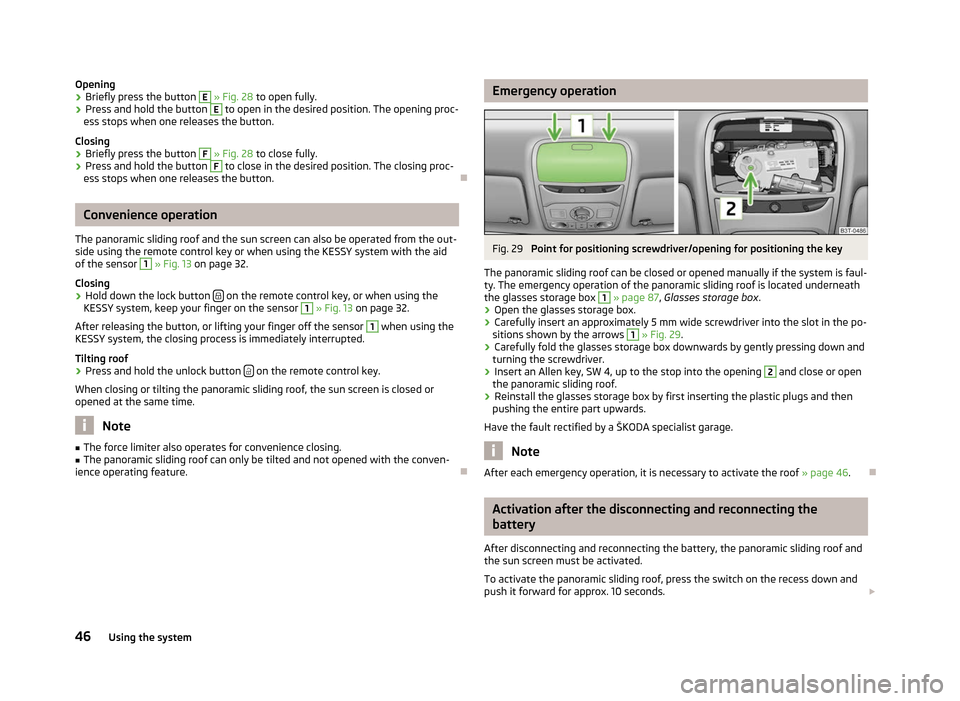
Opening
›
Briefly press the button E
» Fig. 28
to open fully.
› Press and hold the button E
to open in the desired position. The opening proc-
ess stops when one releases the button.
Closing
› Briefly press the button F
» Fig. 28
to close fully.
› Press and hold the button F
to close in the desired position. The closing proc-
ess stops when one releases the button. ÐConvenience operation
The panoramic sliding roof and the sun screen can also be operated from the out-
side using the remote control key or when using the KESSY system with the aid
of the sensor 1
» Fig. 13 on page 32.
Closing
› Hold down the lock button
on the remote control key, or when using the
KESSY system, keep your finger on the sensor 1
» Fig. 13 on page 32
.
After releasing the button, or lifting your finger off the sensor 1
when using the
KESSY system, the closing process is immediately interrupted.
Tilting roof
› Press and hold the unlock button
on the remote control key.
When closing or tilting the panoramic sliding roof, the sun screen is closed or
opened at the same time. Note
■ The force limiter also operates for convenience closing.
■ The panoramic sliding roof can only be tilted and not opened with the conven-
ience operating feature. Ð Emergency operation
Fig. 29
Point for positioning screwdriver/opening for positioning the key
The panoramic sliding roof can be closed or opened manually if the system is faul-
ty. The emergency operation of the panoramic sliding roof is located underneath
the glasses storage box 1
» page 87,
Glasses storage box .
› Open the glasses storage box.
› Carefully insert an approximately 5 mm wide screwdriver into the slot in the po-
sitions shown by the arrows 1
» Fig. 29.
› Carefully fold the glasses storage box downwards by gently pressing down and
turning the screwdriver.
› Insert an Allen key, SW 4, up to the stop into the opening 2
and close or open
the panoramic sliding roof.
› Reinstall the glasses storage box by first inserting the plastic plugs and then
pushing the entire part upwards.
Have the fault rectified by a
ŠKODA specialist garage. Note
After each emergency operation, it is necessary to activate the roof » page 46.Ð Activation after the disconnecting and reconnecting the
battery
After disconnecting and reconnecting the battery, the panoramic sliding roof and
the sun screen must be activated.
To activate the panoramic sliding roof, press the switch on the recess down and
push it forward for approx. 10
seconds. £
46 Using the system
Page 49 of 235
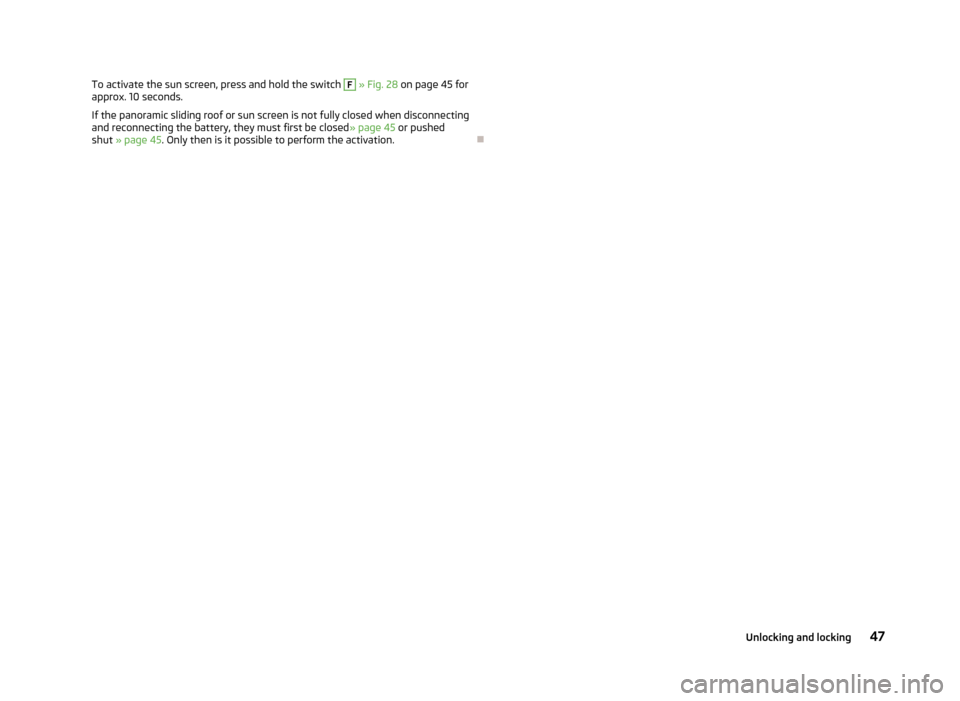
To activate the sun screen, press and hold the switch F
» Fig. 28 on page 45 for
approx. 10 seconds.
If the panoramic sliding roof or sun screen is not fully closed when disconnecting
and reconnecting the battery, they must first be closed » page 45 or pushed
shut » page 45. Only then is it possible to perform the activation. Ð 47
Unlocking and locking
Page 50 of 235

Lights and visibility
Lights
ä
Introduction
This chapter contains information on the following subjects:
Switching lights on and off 49
DAY LIGHT function (Daylight driving light) 49
Automatic driving lamp control 49
Parking light 50
COMING HOME/LEAVING HOME function 50
Adaptive headlights (AHL) 51
Fog lights 52
Fog lights with the function CORNER 52
Rear fog lights 52
Instrument lighting 53
Headlight beam adjustment 53
Switches for the hazard warning light system 53
Turn signal and main beam lever 54
On models fitted with right-hand steering the position of certain switches differs
from that shown in » Fig. 30 on page
49. The symbols which mark the switch
positions are identical, however.
The low beam continues to shine while the ignition is switched on and the light
switch is in the position or . After switching off the ignition, the low beam
is switched off automatically and only the side lights come on. The side lights also
go out after the ignition key is removed. WARNING
■ Never drive with only the side lights on! The side lights are not bright
enough to light up the road sufficiently in front of you or to be seen by other
oncoming traffic. Therefore always switch on the low beam when it is dark or
if visibility is poor.
■ The automatic driving lamp control
only operates as a support and does
not release the driver from his responsibility to check the light and, if necessa-
ry, to switch on the light depending on the light conditions. The light sensor
cannot, for example, detect rain or snow. Under these conditions we recom-
mend switching on the low beam or fog lights! CAUTION
■ The activation of the lights should only be undertaken in accordance with na-
tional legal requirements.
■ The driver is always responsible for the correct settings and use of the lights. Note
■ If the light switch is in the position , the ignition key is removed and the driv-
er's door is open, an audible warning signal will sound. The audible warning signal
is switched off by means of the door contact when the driver's door is closed (ig-
nition off), however, the side lights remain on to illuminate the parked vehicle if
necessary. ■ If there is a fault in the light switch, the low beam comes on automatically.
■ In the event of cool or humid weather conditions, the headlights can be misted
up from inside. The temperature difference between interior and external area of
the headlight lenses is decisive. When the driving lights are switched on, the light
outlet surfaces are free from mist after a short period, although the headlight
lenses may still be misted up in the peripheral areas. It also concerns reverse light
and turn signal lights. This mist has no influence on the life of the lighting system. Ð
48 Using the system